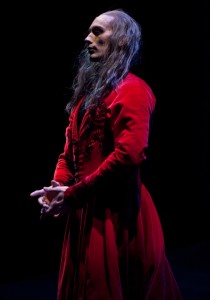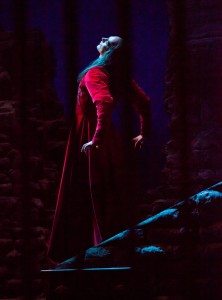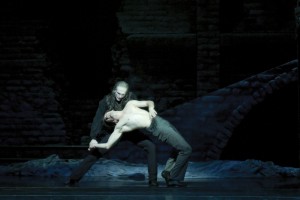
Christian Clark accurately portrays Dracula's monstrous sophistication. Photo by Charlie McCullers, Atlanta Ballet.
Since choreographer Michael Pink first offered his balletic treatment of Bram Stoker’s Dracula in 1997, the tale of the ultimate bloodsucker has danced its way across more ballet stages than you can shake a bat at. Through Feb. 16, the Atlanta Ballet exhumes this tale of tragedy and blood lust for the first time in five years. Though he is returning to this dark Valentine’s tradition for the fourth time, this year mark’s Christian Clark’s first time playing the terrifying title role. With Dracula having three alternating casts, Clark also plays the cowboy Quincy Morris, giving him two drastically different perspectives from one night to the next. Having played both roles during the show’s opening days last weekend, Clark talks to Wrestling with Pop Culture about his conflicting roles in one of literature’s most enduring love stories.
Given the obvious differences between the two characters you portray, how do you prepare for playing each role?
They are very different. The good thing about the two roles is they’re very related to one another. So when I’m not doing Dracula, it’s easy to transition into the other role because throughout the ballet Quincy Morris, alongside Dr. Van Helsing, Jonathan Harker and Arthur, is hunting him. So the story is very interwoven in that way. That change between characters is pretty seamless and not too challenging.
That’s interesting considering the drastically different mindsets of the characters, though I guess they do share the same objects of affection.
This is the fourth time I’ve done this ballet, so I’m pretty familiar with the ins and outs, the intricacies of the music and the whole thing. Had this been my first time doing this production of Dracula, it might have been a bit more challenging. But we’ve done this ballet so many times that I’m very familiar with it.
Have you played these same roles in previous years?
I didn’t do Dracula before. Last time we did it I understudied Dracula. This is the second time I’ve played Quincy, and I’ve done a slew of other characters such as the undead, the holiday couple in Whitby, one of the villagers in Transylvania.
In the years that you’ve been involved with this production, how much does it change from one year to the next?
Michael Pink, the choreographer, has elaborated a bit more on the little details of each character, so there are minor changes in that way. They did just relight the ballet, so the lighting is actually quite a bit different. I feel Dave Grill’s lighting is just spectacular.
The lighting in this show definitely adds to the spectacle, especially in the scenes with Renfield is in his cell and the effect of light shining through his window.
Grill is a master when it comes to lighting and that all helps you get into character when you feel like all the elements are coming together: the lighting, the makeup, the orchestra. If all the parts aren’t fitting together, it’s a bit hard to find yourself on stage and in character.
Dracula is one of the most reinterpreted stories ever. How does this show and that character compare to other ballet roles you’ve played? Why do you think Dracula is such an enduring story?
All the elements of the story are probably why people keep wanting us to do it again. You’ve really got something for everybody. There’s the horrific side of it, and that’s terrifying in some ways. There’s action, adventure, lust, romance, passion – I just think the book and the story have all those elements that make up a truly great and visually-pleasing story to be on stage. Some other classical ballets that we do don’t have all those elements to keep people drawn in. Some girls and older women really like Swan Lake, but you might have a hard time drawing a guy’s attention into a show like that. Whereas in Dracula there really is something for everybody.
One thing I really enjoy about this production is it is one of the more accurate portrayals of the Dracula character from the book. There have been several interpretations, but he is usually portrayed as an almost gentlemanly romantic rather than a monster. How do you go about portraying this character through dance?

Christian Clark gets animalistic in his portrayal of Dracula. Photo by Charlie McCullers, Atlanta Ballet.
Exactly. A lot of the choreography that Michael Pink has done was meant to look almost like an animal. There are times that are meant to mimic a wolf, there are times that are times when our steps imitate a bat, so it’s actually pretty fun because you tap into a very primal side of yourself. I think not having inhibitions out on stage and not being worried about the technical side of each step that you’re doing, but having the source of that feeling coming from those ideas of animalism and brute strength and a lust for blood is interesting.
Dracula runs through this Saturday. What’s next for you?
I’m really excited about David Bintley‘s Carmina Burana. We’re doing Ohad Naharin‘s Minus 16 before that and I’m really excited about that one. Our resident choreographer Helen Pickett has done two pieces that we’re doing this season. One of them is called Prayer of Touch, which I did last year and am really excited to do again. Her other ballet, which I wasn’t in last time, is called Petal and it was one of my favorite things I’ve seen the company do in a long time. Hopefully this go round I might get a chance to do that one.

